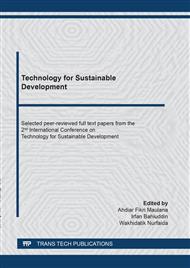[1]
Information on https://citeseerx.ist.psu.edu/viewdoc/download?doi=10.1.1.319.1769&rep=rep1&type=pdf (P.D. Babu, R. Bhakyaraj, R. Vidhyalakshmi, A low cost nutritious food tempeh,- A review, World J. Dairy & Food Sci 4 (2009) 22–27).
Google Scholar
[2]
Information on https://www.bps.go.id/statictable/2014/09/08/950/rata-rata-konsumsi-per-kapita-seminggu-beberapa-macam-bahan-makanan-penting-2007-2018.html (BPS – Badan Pusat Statistik (2021), Rata-rata konsumsi per kapita seminggu beberapa macam bahan penting, year 2015–2019).
DOI: 10.33603/e.v7i2.2974
Google Scholar
[3]
M. Astawan, T. Wresdiyati, J. Sirait, Effect of Grobogan soybean tempe consumption on rats' serum profiles, hematology, and antioxidant, J. Teknol. dan Industri Pangan 26 (2015) 155–162.
DOI: 10.6066/jtip.2015.26.2.155
Google Scholar
[4]
I. Kusumawati, M. Astawan and E. Prangdimurti, Production process efficiency and character-istic of tempe from dehulled soybean, J. Pangan 29 (2020) 117–26.
DOI: 10.33964/jp.v29i2.492
Google Scholar
[5]
Information on https://www.researchgate.net/publication/336141441_DESIGNING_SOYBEAN_PEEL_SEPARATOR_CONTAINER_USING_REVERSE_ENGINEERING_METHOD_FOR_DECREASING_THE_CYCLE_TIME (F. Abdulhakim, A. Kusnayat and S. Martini, Designing soybean peel separator container using reverse engineering method for decreasing the cycle time, e-Proceeding Eng. 5 (2018) 6973–6980).
DOI: 10.17501/2682728x.2020.1102
Google Scholar
[6]
Information on https://repository.uksw.edu/bitstream/123456789/3028/2/PROS_%20Bary%20F%2c%20Susanti%20PHi%2c%20Santoso%20S_%20Pemanfaatan%20Limbah%20Cair_Full%20text.pdf (B. Fratama, S.P. Hastuti and S. Santoso, Pemanfaatan limbah cair industri tempe sebagai pupuk cair produktif (PCP) ditinjau dari penambahan pupuk NPK, Pros. Semin. Nas. Sains dan Pendidik, Sains, VIII (2013) 4 416).
DOI: 10.25037/pancaran.v6i1.10
Google Scholar
[7]
Information on https://inis.iaea.org/collection/NCLCollectionStore/_Public/50/062/50062778.pdf?r=1 (S.W. Puspawati, Alternative waste treatment of tempe industrial with combination method of filtration and phytoremediation, Pros. Semin. Nas. Teknol. Pengolahan Limbah 15 (2017) 129–36).
Google Scholar
[8]
M. Azhari, Pengolahan limbah tahu dan tempe dengan metode teknologi tepat guna saringan pasir sebagai kajian mata kuliah pengetahuan media, Ilm. Tek. Lingkung. 1 (2016) 1–8.
DOI: 10.33084/mitl.v1i2.140
Google Scholar
[9]
I. Lia Novenda, P. Pujiastuti and S. Andi Nugroho, Pemanfaatan limbah cair singkong dan industri tempe kedelai sebagai alternatif pupuk organik cair, Pancaran Pendidikan 6 (2017) 107.
DOI: 10.25037/pancaran.v6i1.10
Google Scholar
[10]
Information on https://jurnal.ipb.ac.id/index.php/pim/article/view/31398 (P. Supinah, W.F. Setiawan and S.P. Mulya, Sosialisasi pemanfaatan limbah tempe sebagai pupuk organik cair untuk pengelolaan berkelanjutan di Desa Kuripan Kertoharjo, J. Pus. Inov. Masy. 2 (2020) 642–6).
DOI: 10.33292/mayadani.v1i2.17
Google Scholar
[11]
M.J.R. Nout, M.A. de Dreu, A.M. Zuurbier, T.M.G. Bonants-van Laarhoven, Ecology of controlled soyabean acidification for tempe manufacture, Food Microbiol. 4 (1987) 165-172.
DOI: 10.1016/0740-0020(87)90032-3
Google Scholar
[12]
G. Tuncel, M.J.R. Nout, F.M. Rombouts, Effect of acidification on the microbiological composition and performance of tempe starter, Food Microbiol. 6 (1989) 37–43.
DOI: 10.1016/s0740-0020(89)80035-8
Google Scholar
[13]
E. Nahas, Control of lipase production by Rhizopus oligosporus under various growth conditions. J. Gen. Microbiol. 134 (1988) 227–33.
DOI: 10.1099/00221287-134-1-227
Google Scholar
[14]
X.-M. Feng, Microbial dynamics during barley tempeh fermentation. Swedish University of Agricultural Sciences (2006) 52.
Google Scholar
[15]
J .C. de Reu, D. Ramdaras, F.M. Rombouts, M.J.R. Nout, Changes in soya bean lipids during tempe fermentation, Food Chem. 50 (1994) 171–175.
DOI: 10.1016/0308-8146(94)90116-3
Google Scholar
[16]
Information on https://doi.org/10.1021/jf981279u (R.A. Sparringa, J.D. Owens, Protein utilization during soybean tempe fermentation, J. Agric. Food Chem. 47 (1999) 4375−4378).
DOI: 10.1021/jf981279u
Google Scholar
[17]
Information on http://www.forumtempe.org/images/resep/8625_SNI%203144-2015.pdf.
Google Scholar


